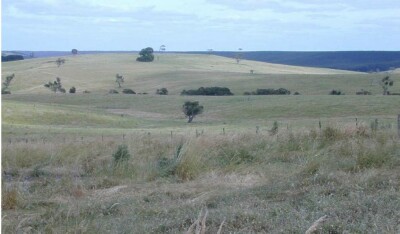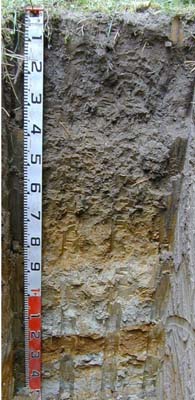ASH98 (plot 3)
| Site: ASH98 (Plot 3) | Land Unit: Digby |
 |
General Land Unit Description: As with the Merino Tablelands land unit, the Digby land unit also occurs on the Cretaceous nonmarine sandstone of the Merino Tablelands. The soils on the Digby land unit differ from the Merino Tablelands land unit as they tend to be slightly more acidic in the top of the subsoil and have more ferruginous nodules (Ferric Brown Chromosols). The division between the two land units is highlighted in recent radiometric imagery. Black Chromosols, Dermosols and Vertosols, similar to the Merino land unit also occur. 2.5 year old Eucalyptus globulus plantation on ex-agricultural land. |
Site Description:
| Geology: Cretaceous non-marine sandstone | Landform pattern: Undulating plain |
| Internal drainage: Imperfectly drained |
Soil Profile Morphology
| A11 | 0-20 cm | Very dark greyish brown (10YR3/2) clay loam; weak polyhedral structure (20-50 mm); firm consistence when dry; common very fine macropores; areal porosity 0.1%; many medium roots; gradual and smooth transition to: |  |
| A12 | 20-40 cm | Dark brown (10YR3/3) clay loam; weak polyhedral structure (20-50 mm) parting to weak granular structure (10-20 mm); firm consistence when moderately moist; common very fine macropores; areal porosity 0.1%; few fine roots; clear and smooth transition to: | |
| Subsoil | |||
| B1 | 40-50 cm | Dark brown (10YR3/3) with common medium faint brownish yellow (10YR6/8) mottles, light clay; weak angular blocky structure (50-100 mm) parting to weak angular blocky structure (10-20 mm); firm consistence when moderately moist; few very fine macropores; areal porosity 0.05%; few fine roots; gradual and smooth transition to: | |
| B21 | 50-70 cm | Yellowish brown (10YR5/4) with many medium faint very dark greyish brown (10YR3/2) mottles, medium clay; weak angular blocky structure (50-100 mm); firm consistence when moderately moist; few very fine macropores; areal porosity 0.03%; few fine roots; clear and smooth transition to: | |
| B22 | 70-90 cm | Strong brown (7.5YR5/6) with many medium faint reddish yellow (7.5YR6/8) and red (2.5YR4/8) mottles, medium clay; weak subangular blocky structure (50-100 mm); firm consistence when moderately moist; common very fine macropores; areal porosity 0.1%; few fine roots; clear and smooth transition to: | |
| B3 | 90-115 cm | Light grey (10YR7/2) with few medium distinct brownish yellow (10YR6/8) mottles, medium clay; weak subangular blocky structure (20-50 mm) parting to weak subangular blocky structure (10-20 mm); firm consistence when moderately moist; common very fine macropores; areal porosity 0.1%; few fine roots; sharp and smooth transition to: | |
| C1 | 115-130 cm | Strong brown (7.5YR4/6), clayey sand; single grain structure; very weak consistence when moderately moist; few very fine macropores; areal porosity 0.05%; few very fine roots; sharp and smooth transition to: | |
| C2 | 130-150 cm | White (10YR8/1), silty clay; massive structure; weak consistence when moderately moist; few very fine macropores; areal porosity 0.05%; no roots observed. | |
| 150-350 cm | Medium to heavy grey clays, live roots observed to 300 cm along remnant root channels. | ||
| 350-390 cm | Purple/black Miocene mudstones with plant remains (carbonaceous). | ||
Notes: The Mudstone layer does not appear to offer a large water holding capacity.
Sampled by: Ian Sargeant, Paul Feikema and Martin Clark (6 December 2000)


